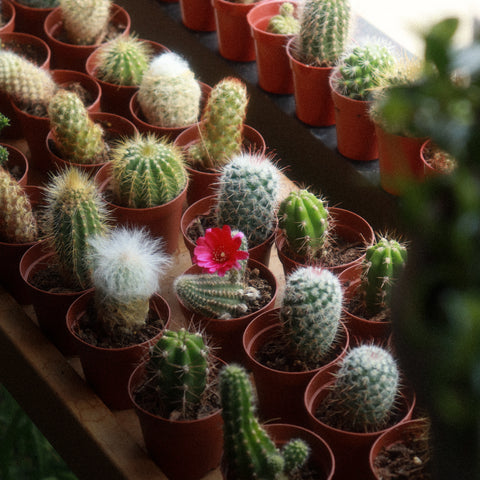

LIGHT
Cacti are native to hot, arid climates with intense sunlight. Place cacti in the brightest possible light within your home. A south-facing window is ideal to recreate natural conditions.
If these conditions cannot be achieved with natural light, introducing artificial light (a grow light) is recommended.
WATER
Allow the potting media (soil) to dry out completely between watering in order to prevent root rot. Once the potting mix is completely dry from top to bottom (and only then!), water thoroughly. Allow the water to soak in until the potting mix is saturated, then wait until it’s completely dry to water again.
Bottom watering (placing the plant in a dish of water and allowing its soil to soak up water through the bottom drainage hole) is an excellent method to water any cacti because the dry potting media often prevents water absorption when top watering. This phenomena is referred to as "hydrophobic soil."
Cacti are succulents, and succulents have evolved to require a dry period. However, when it's appropriate to water, completely soak the potting mix. Recreating this rhythm of drought and downpour is key to caring for succulents - including cacti. Furthermore, watering a succulent with an ice cube or just a trickle of water will lead to stunted growth and malnutrition over time.
Watering frequency should be reduced during winter months when slower growth or dormancy occurs. Additionally, sunlight is not as intense, and the potting mix may take longer to completely dry out.
POTTING MIX
Cacti are native to arid environments where they often grow in sandy, dry substrates. Use a coarse, very fast draining cacti/succulent potting mix.
Our house blend can be found here. (LINK THIS)
When repotting any plant; including cacti; selecting a planter with drainage (a hole in the bottom for excess water to escape) will make watering much simpler and will help the plant stay healthy.
PET SAFETY
Although cacti are generally considered non-toxic to pets, we do advise caution. Spikes are sharp!
Often times highly-toxic Euphorbia are mislabeled as Cacti because of similarities in appearance. Euphorbia should be kept away from pets and children.
FOR A DETAILED LIST OF TOXIC PLANTS, VISIT THE LINK BELOW.
